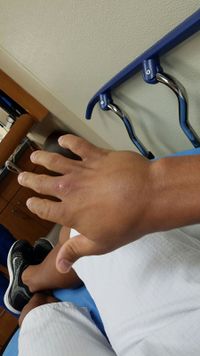Hand and Wrist Sports Injuries
This article or area is currently under construction and may only be partially complete. Please come back soon to see the finished work! (15/03/2020)
Original Editor - Your name will be added here if you created the original content for this page.
Top Contributors - Lucinda hampton, Chrysolite Jyothi Kommu, Temitope Olowoyeye, Khloud Shreif, Tony Lowe, Kim Jackson, Vidya Acharya and Wanda van Niekerk
Introduction[edit | edit source]
With so many bones, ligaments, tendons, and joints keeping hands and wrists working, there is ample opportunity for injury. In fact, injuries to the hand and wrists are some of the most common ailments facing athletes.
- Approximately 25 % of all sports-related injuries involve the hand or wrist
- If managed properly most athletes can expect their injury to heal without any significant long-term disability.[1]
- Incidence is growing not only due to the competitive level of high school and collegiate athletes but also due to the activity level of the general population
- Hand and wrist injuries are common and can have a significant impact especially if initially disregarded with a resultant delay to treatment[2].
Common Sports Related Injuries.[edit | edit source]
Knowledge of common sports-related injuries and therapeutic strategies can help the physiotherapist effectively treat the athlete considering their sports, position, and timing during season.
Radial-sided wrist injuries[edit | edit source]
Radial-sided tendinopathies:
- de Quervain’s tenosynovitis;
- Intersection syndrome, also called Oarsman’s wrist, is caused by friction at the crossing of the tendons of the first extensor compartment as they pass over the tendons of the second extensor compartment (extensor carpi radialis longus and brevis) or a stenosing tenosynovitis within the second extensor compartment itself. Pain is elicited with extension and radial deviation approximately 4–8 cm proximal to the radial styloid. Without careful attention to the location of pain, this can be misdiagnosed as de Quervain’s tenosynovitis.;
- Tendonitis of the flexor carpi radialis is due to repetitive wrist flexion or acute overstretching of the wrist as can be seen in volleyball or water polo. Pain develops from tendon thickening as it runs in its tunnel adjacent to the carpal tunnel. Pain typically courses from the radial palmar wrist crease towards the base of the second metacarpal made worse by resisted wrist flexion.
Ulnar-sided wrist injuries[edit | edit source]
Extensor carpi ulnaris injury - Abnormalities of the extensor carpi ulnaris (ECU) covers an array of pathologies seen in golf, baseball, hockey, tennis players, and other racquet sports. Injury may present as acute or chronic encompassing tendinosis, subluxation, dislocation, or rupture causing pain with or without mechanical symptoms on the ulnar side of the wrist. The pathophysiology involves repetitive microtrauma or a sudden traumatic episode during wrist flexion, supination, and ulnar deviation such as the nondominant hand in a double-handed backhand in tennis or the leading hand in the downward phase of a golf stroke.
Triangular fibrocartilage complex tears
Hook of the hamate fractures
Hand/finger injuries[edit | edit source]
Thumb ulnar collateral ligament tears - Ulnar collateral ligament (UCL) injuries of the thumb are extremely common and often seen in skiing, basketball, and football. Injury occurs from an abduction moment at the thumb metacarpophalangeal joint (MCPJ) such as a fall onto an outstretched hand with the thumb abducted. An acute thumb UCL injury has been dubbed a skier’s thumb in contrast to chronic attritional insufficiency of the ligament which is referred to as a gamekeeper’s thumb
Metacarpal/phalangeal fractures - Accounting for 10 % of all fractures presenting to the emergency department, metacarpal and phalangeal fractures are common injuries. Injuries occur from falls, direct blows, or crush during sporting activity, although stress fractures have rarely been noted in racquet sports. Incidence is highest in contact sports such as football, lacrosse, and hockey
Metacarpal fractures - Metacarpal base fractures occur from an axial load with the wrist in flexion. eg Bennett and reverse-Bennett fractures are used to describe the characteristic fractures of the thumb and small finger metacarpal.
Phalangeal fractures - Shaft fractures of the proximal and middle phalanges can occur in a variety of patterns, but buddy taping and/or protective splint wear in acceptable alignment can allow fast return to play. Extra-articular fractures without rotational malalignment, less than 15°of angulation, and less than 6 mm of shortening are indicated for conservative treatment. Operative fixation with open versus closed reduction using either K-wires, screws, or plate and screws as fixation is sometimes required, especially when there is digital malrotation
Traumatic Extensor Hood Rupture
Extensor Tendon Injuries of the Fingers and Hand
Pulley ruptures - Closed annular pulley ruptures occur most commonly in rock climbers due to the high demand placed on the flexor tendon system in the hanging and crimping positions.eg trigger finger Pulley ruptures typically involve the A2 or A4 pulleys and occur most often in the middle and ring fingers. Previous work has evaluated the force required to produce an A2 pulley tear and loads experienced during these vulnerable maneuvers finding they are at particular risk for climbers.
Sub Heading 3[edit | edit source]
Conclusion[edit | edit source]
<section> Hand and wrist injuries in athletics are common and can have a significant impact in multiple areas. Knowledge of these entities and special consideration for the athlete can help the team physician effectively treat these players and help them achieve their goals. </section><section>
Abbreviations[edit | edit source]
</section>
- bulleted list
- x
or
- numbered list
- x
References[edit | edit source]
- ↑ American society for sports medicine Hand and Wrist Injuries EXPERT CONSULTANT: Dan Matth Available from:https://www.sportsmed.org/aossmimis/STOP/Downloads/SportsTips/HandandWristInjuries.pdf (last accessed 15.3.2020)
- ↑ Avery DM, Rodner CM, Edgar CM. Sports-related wrist and hand injuries: a review. Journal of orthopaedic surgery and research. 2016 Dec 1;11(1):99. Available from:https://josr-online.biomedcentral.com/articles/10.1186/s13018-016-0432-8 (last accessed 15.3.2020)







